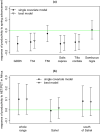The influence of climate variability on demographic rates of avian Afro-palearctic migrants
- PMID: 33067507
- PMCID: PMC7567877
- DOI: 10.1038/s41598-020-74658-w
The influence of climate variability on demographic rates of avian Afro-palearctic migrants
Abstract
Climate is an important driver of changes in animal population size, but its effect on the underlying demographic rates remains insufficiently understood. This is particularly true for avian long-distance migrants which are exposed to different climatic factors at different phases of their annual cycle. To fill this knowledge gap, we used data collected by a national-wide bird ringing scheme for eight migratory species wintering in sub-Saharan Africa and investigated the impact of climate variability on their breeding productivity and adult survival. While temperature at the breeding grounds could relate to the breeding productivity either positively (higher food availability in warmer springs) or negatively (food scarcity in warmer springs due to trophic mismatch), water availability at the non-breeding should limit the adult survival and the breeding productivity. Consistent with the prediction of the trophic mismatch hypothesis, we found that warmer springs at the breeding grounds were linked with lower breeding productivity, explaining 29% of temporal variance across all species. Higher water availability at the sub-Saharan non-breeding grounds was related to higher adult survival (18% temporal variance explained) but did not carry-over to breeding productivity. Our results show that climate variability at both breeding and non-breeding grounds shapes different demographic rates of long-distance migrants.
Conflict of interest statement
The authors declare no competing interests.
Figures


Similar articles
-
Climatic effects on breeding grounds are more important drivers of breeding phenology in migrant birds than carry-over effects from wintering grounds.Biol Lett. 2013 Nov 6;9(6):20130669. doi: 10.1098/rsbl.2013.0669. Print 2013. Biol Lett. 2013. PMID: 24196517 Free PMC article.
-
Patterns of bird migration phenology in South Africa suggest northern hemisphere climate as the most consistent driver of change.Glob Chang Biol. 2015 Jun;21(6):2179-90. doi: 10.1111/gcb.12857. Epub 2015 Mar 6. Glob Chang Biol. 2015. PMID: 25640890
-
Avian migration phenology and global climate change.Proc Natl Acad Sci U S A. 2003 Oct 14;100(21):12219-22. doi: 10.1073/pnas.1930548100. Epub 2003 Sep 30. Proc Natl Acad Sci U S A. 2003. PMID: 14519854 Free PMC article.
-
The effects of long-distance migration on the evolution of moult strategies in Western-Palearctic passerines.Biol Rev Camb Philos Soc. 2019 Apr;94(2):700-720. doi: 10.1111/brv.12474. Epub 2018 Oct 18. Biol Rev Camb Philos Soc. 2019. PMID: 30334341 Review.
-
Emergence of long distance bird migrations: a new model integrating global climate changes.Naturwissenschaften. 2008 Dec;95(12):1109-19. doi: 10.1007/s00114-008-0435-3. Epub 2008 Aug 19. Naturwissenschaften. 2008. PMID: 18712337 Review.
Cited by
-
Species Traits Drive Long-Term Population Trends of Common Breeding Birds in Northern Italy.Animals (Basel). 2021 Dec 1;11(12):3426. doi: 10.3390/ani11123426. Animals (Basel). 2021. PMID: 34944203 Free PMC article.
-
Species-specific traits mediate avian demographic responses under past climate change.Nat Ecol Evol. 2023 Jun;7(6):862-872. doi: 10.1038/s41559-023-02055-3. Epub 2023 Apr 27. Nat Ecol Evol. 2023. PMID: 37106156
-
Avian migration clocks in a changing world.J Comp Physiol A Neuroethol Sens Neural Behav Physiol. 2024 Jul;210(4):691-716. doi: 10.1007/s00359-023-01688-w. Epub 2024 Feb 2. J Comp Physiol A Neuroethol Sens Neural Behav Physiol. 2024. PMID: 38305877 Free PMC article. Review.
-
The Complex Relationship Between High Temperatures and Avian Breeding Success: Insights From a Global Review.Ecol Evol. 2025 Jul 28;15(8):e71771. doi: 10.1002/ece3.71771. eCollection 2025 Aug. Ecol Evol. 2025. PMID: 40740806 Free PMC article. Review.
-
Survival fluctuation is linked to precipitation variation during staging in a migratory shorebird.Sci Rep. 2022 Nov 18;12(1):19830. doi: 10.1038/s41598-022-24141-5. Sci Rep. 2022. PMID: 36400908 Free PMC article.
References
-
- Hawkins BA, et al. Energy, water, and broad-scale geographic patterns of species richness. Ecology. 2003;84:3105–3117. doi: 10.1890/03-8006. - DOI
-
- Sanderson FJ, Donald PF, Pain DJ, Burfield IJ, van Bommel FPJ. Long-term population declines in Afro-Palearctic migrant birds. Biol. Conserv. 2006;131:93–105. doi: 10.1016/j.biocon.2006.02.008. - DOI
Publication types
MeSH terms
LinkOut - more resources
Full Text Sources
Other Literature Sources
Miscellaneous

